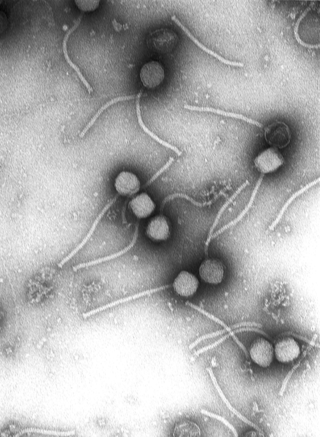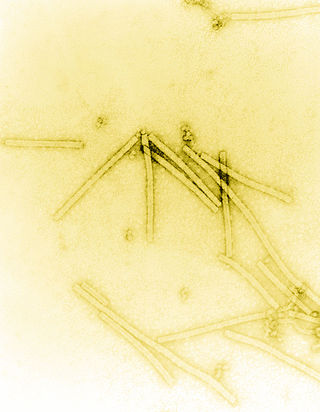
Virology is the scientific study of biological viruses. It is a subfield of microbiology that focuses on their detection, structure, classification and evolution, their methods of infection and exploitation of host cells for reproduction, their interaction with host organism physiology and immunity, the diseases they cause, the techniques to isolate and culture them, and their use in research and therapy.

Salvador Edward Luria was an Italian microbiologist, later a naturalized U.S. citizen. He won the Nobel Prize in Physiology or Medicine in 1969, with Max Delbrück and Alfred Hershey, for their discoveries on the replication mechanism and the genetic structure of viruses. Salvador Luria also showed that bacterial resistance to viruses (phages) is genetically inherited.

Cell is a peer-reviewed scientific journal publishing research papers across a broad range of disciplines within the life sciences. Areas covered include molecular biology, cell biology, systems biology, stem cells, developmental biology, genetics and genomics, proteomics, cancer research, immunology, neuroscience, structural biology, microbiology, virology, physiology, biophysics, and computational biology. The journal was established in 1974 by Benjamin Lewin and is published twice monthly by Cell Press, an imprint of Elsevier.

The International Committee on Taxonomy of Viruses (ICTV) authorizes and organizes the taxonomic classification of and the nomenclature for viruses. The ICTV develops a universal taxonomic scheme for viruses, and thus has the means to appropriately describe, name, and classify every virus taxon. The members of the International Committee on Taxonomy of Viruses are considered expert virologists. The ICTV was formed from and is governed by the Virology Division of the International Union of Microbiological Societies. Detailed work, such as identifying new taxa and delimiting the boundaries of species, genera, families, etc. typically is performed by study groups of experts in the families.

Journal of General Virology is a not-for-profit peer-reviewed scientific journal published by the Microbiology Society. The journal was established in 1967 and covers research into animal, insect and plants viruses, also fungal viruses, prokaryotic viruses, and TSE agents. Antiviral compounds and clinical aspects of virus infection are also covered.

Antiviral Research is a monthly peer-reviewed medical journal published by Elsevier covering research on all aspects of the development of drugs, vaccines and immunotherapies against viruses of animals and plants. The journal was established in 1981 and is an official publication of the International Society for Antiviral Research. The editor-in-chief is Subhash Vasudevan.

A virus is a tiny infectious agent that reproduces inside the cells of living hosts. When infected, the host cell is forced to rapidly produce thousands of identical copies of the original virus. Unlike most living things, viruses do not have cells that divide; new viruses assemble in the infected host cell. But unlike simpler infectious agents like prions, they contain genes, which allow them to mutate and evolve. Over 4,800 species of viruses have been described in detail out of the millions in the environment. Their origin is unclear: some may have evolved from plasmids—pieces of DNA that can move between cells—while others may have evolved from bacteria.

The history of virology – the scientific study of viruses and the infections they cause – began in the closing years of the 19th century. Although Edward Jenner and Louis Pasteur developed the first vaccines to protect against viral infections, they did not know that viruses existed. The first evidence of the existence of viruses came from experiments with filters that had pores small enough to retain bacteria. In 1892, Dmitri Ivanovsky used one of these filters to show that sap from a diseased tobacco plant remained infectious to healthy tobacco plants despite having been filtered. Martinus Beijerinck called the filtered, infectious substance a "virus" and this discovery is considered to be the beginning of virology.
Anthony (Tony) Charles Minson, PhD, FMedSci is a British virologist known for his work on the biology of herpesviruses, and a university administrator. He was the Senior Pro-Vice-Chancellor of the University of Cambridge from 2003 to 2009. He is an emeritus professor of virology at the university's Department of Pathology and an emeritus fellow of Wolfson College.
Retrovirology is a peer-reviewed open access scientific journal covering basic research on retroviruses. The journal was established in 2004 and is published by BioMed Central. The editors-in-chief are Johnson Mak and Susan Ross ; earlier, Kuan-Teh Jeang was editor-in-chief.

George Keble Hirst, M.D. was an American virologist and science administrator who was among the first to study the molecular biology and genetics of animal viruses, especially influenza virus. He directed the Public Health Research Institute in New York City (1956–1981), and was also the founding editor-in-chief of Virology, the first English-language journal to focus on viruses. He is particularly known for inventing the hemagglutination assay, a simple method for quantifying viruses, and adapting it into the hemagglutination inhibition assay, which measures virus-specific antibodies in serum. He was the first to discover that viruses can contain enzymes, and the first to propose that virus genomes can consist of discontinuous segments. The New York Times described him as "a pioneer in molecular virology."

The Annual Review of Virology is an annual peer-reviewed scientific journal published by Annual Reviews. The journal covers all aspects of virology. It was established in 2014 and led by editor Lynn W. Enquist until October 2023 when Terence S. Dermody succeeded her. As of 2021, Annual Review of Virology was published as open access, under the Subscribe to Open model.
Rhinolophus bat coronavirus HKU2 is a novel enveloped, single-stranded positive-sense RNA virus species in the Alphacoronavirus, or Group 1, genus with a corona-like morphology.
Scotophilus bat coronavirus 512 is an enveloped, single-stranded positive-sense RNA virus species in the Alphacoronavirus, or Group 1, genus with a corona-like morphology. It was isolated from a lesser Asiatic yellow house bat discovered in southern China.
The American Society for Virology (ASV) is an American scientific society serving the community of researchers in virology. The organization was founded in 1981 and was the first scientific society in the world dedicated exclusively to virology.
Wolfgang Karl "Bill" Joklik was a virologist and James B. Duke Professor Emeritus of Molecular Genetics and Microbiology at Duke University, from which he retired in 1993 after 25 years chairing the department. In 1981, he founded the American Society for Virology, the first scientific society specifically for virologists, and served a two-year term as its founding president. In the same year, he was elected to the United States National Academy of Sciences. He has been described as "one of the earliest molecular virologists" and is best known for his research on poxviruses and reoviruses, and for work on interferon proteins.
Robert R. Wagner (1923–2001) was an American virologist who spent time on the faculty at Yale University, Johns Hopkins University, and finally the University of Virginia School of Medicine, from which he retired as professor emeritus in 1994. His research focused on the vesicular stomatitis virus. Wagner died of cancer in 2001.

Shahid Jameel is an Indian virologist and academic. Dr. Jameel is the Sultan Qaboos bin Said Fellow at Oxford Centre for Islamic Studies and Research Fellow, Green Templeton College, University of Oxford. He serves as the Principal Investigator for the Centre's project on Public Health, Science and Technology in Muslim societies. Previously he was the director of the Trivedi School of Biosciences since its inception in the year 2020 at Ashoka University. He was formerly head of the scientific advisory group to the Indian SARS-CoV-2 Genomics Consortia (INSACOG) established in December 2020, and the chief executive officer of Wellcome Trust DBT India Alliance. Known for his research in hepatitis E virus, Jameel is an elected fellow of all the three major Indian science academies viz. National Academy of Sciences, India, Indian Academy of Sciences, and Indian National Science Academy. The Council of Scientific and Industrial Research, the apex agency of the Government of India for scientific research, awarded him the Shanti Swarup Bhatnagar Prize for Science and Technology, one of the highest Indian science awards for his contributions to Medical Sciences in 2000.
Johannes A. Jehle is a German scientist for insect virology, and plant protection. The focus of his research is the use of microorganisms and viruses for biological control of insect pests and the development of sustainable methods for plant protection. He heads the Institute for Biological Plant Control of the Julius Kühn-Institut in Darmstadt and is an adjunct Professor at the Technical University Darmstadt. He was President of the Society of Invertebrate Pathology in 2016/2018.
The World Society for Virology was established in 2017 in order to link different virologists worldwide in an official society with no restriction based on income or physical location. The society aims to strengthen research on viruses affecting humans, animals, plants and other organisms.












